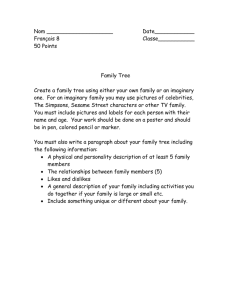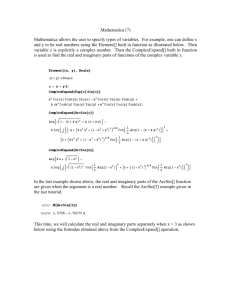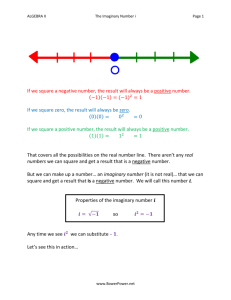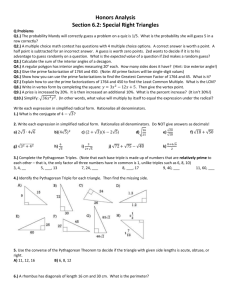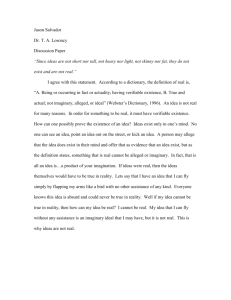4.3.1 Defining Complex Numbers
advertisement
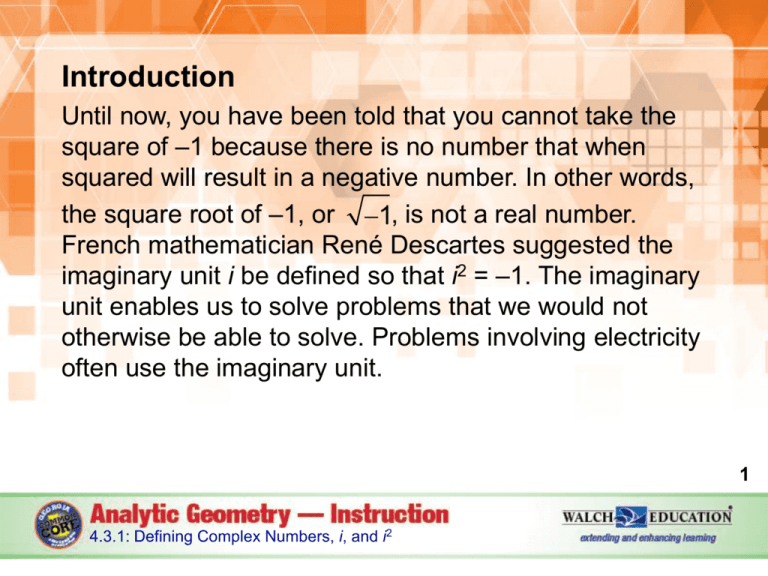
Introduction Until now, you have been told that you cannot take the square of –1 because there is no number that when squared will result in a negative number. In other words, the square root of –1, or -1, is not a real number. French mathematician René Descartes suggested the imaginary unit i be defined so that i2 = –1. The imaginary unit enables us to solve problems that we would not otherwise be able to solve. Problems involving electricity often use the imaginary unit. 1 4.3.1: Defining Complex Numbers, i, and i2 Key Concepts • All rational and irrational numbers are real numbers. • The imaginary unit i is used to represent the nonreal -1 value, . • An imaginary number is any number of the form bi, -1 where b is a real number, i = , and b ≠ 0. • Real numbers and imaginary numbers can be combined to create a complex number system. • A complex number contains two parts: a real part and an imaginary part. 2 4.3.1: Defining Complex Numbers, i, and i2 Key Concepts, continued • All complex numbers are of the form a + bi, where a and b are real numbers and i is the imaginary unit. • In the general form of a complex number, a is the real part of the complex number, and bi is the imaginary part of the complex number. Note that if a = 0, the complex number a + bi is wholly imaginary and contains no real part: 0 + bi = bi. • If b = 0, the complex number a + bi is wholly real and contains no imaginary part: a + (0)i = a. • Expressions containing imaginary numbers can also be simplified. 3 4.3.1: Defining Complex Numbers, i, and i2 Key Concepts, continued • To simplify in for n > 4, divide n by 4, and use the properties of exponents to rewrite the exponent. • The exponent can be rewritten using the quotient: n r n ÷ 4 = m remainder r, or = m + , where r is the 4 4 remainder when dividing n by 4, and m is a whole number. • Then n = 4m + r, and r will be 0, 1, 2, or 3. Use the properties of exponents to rewrite in. in = i 4m + r = i 4m • i r 4 4.3.1: Defining Complex Numbers, i, and i2 Key Concepts, continued • i 4 = 1, so i to a multiple of 4 will also be 1: i 4m = (i 4)m = (1)m = 1. • The expression i r will determine the value of in. • Use i 0, i 1, i 2, and i 3 to find in. If r = 0, then: If r = 1, then: in = i 4m + r in = i 4m + r in = i 4m • ir in = i 4m • i r in = 1 • i 0 in = 1 • i 1 in = 1 • 1 = 1 in = i, or -1 5 4.3.1: Defining Complex Numbers, i, and i2 Key Concepts, continued If r = 2, then: If r = 3, then: in = i 4m + r in = i 4m + r in = i 4m • ir in = i 4m • i r in = 1 • i 2 in = 1 • i 3 in = 1 • –1 = –1 in = i • –1 = –i, or - -1 • Only the value of the remainder when n is divided by 4 is needed to simplify in. i 0 = 1, i 1 = i, i 2 = –1, and i 3 = –i 6 4.3.1: Defining Complex Numbers, i, and i2 Key Concepts, continued • Properties of exponents, along with replacing i with its equivalent value of -1, can be used to simplify the expression in. Start with n = 0. i0 = 1 i 1 = i = -1 i = 2 ( -1) 2 = -1 7 4.3.1: Defining Complex Numbers, i, and i2 Key Concepts, continued • When simplifying i 3, use the property i 3 = i 2 • i 1, and the determined values of i 2 and i. i 3 = i 2 · i = ( -1) · -1 = - -1, or - i • When simplifying i 4, use the property i 4 = i 2 • i 2, and the determined value of i 2. i 4 = i 2 · i 2 = (-1) · (-1) = 1 8 4.3.1: Defining Complex Numbers, i, and i2 Common Errors/Misconceptions • incorrectly identifying the real and imaginary parts of a complex number • assuming that a real number isn’t part of the complex number system • incorrectly dividing a power of i by 4 • incorrectly simplifying the expressions i 2, i 3, and i 4, including stating i 2 = 1 9 4.3.1: Defining Complex Numbers, i, and i2 Guided Practice Example 3 Rewrite the radical -32 using the imaginary unit i. 10 4.3.1: Defining Complex Numbers, i, and i2 Guided Practice: Example 3, continued 1. Rewrite the value under the radical as the product of –1 and a positive value. -32 = ( -1) · 32 11 4.3.1: Defining Complex Numbers, i, and i2 Guided Practice: Example 3, continued 2. Rewrite the radical as i. ( -1) · 32 = -1· 32 = i · 32 12 4.3.1: Defining Complex Numbers, i, and i2 Guided Practice: Example 3, continued 3. If possible, rewrite the positive value as the product of a square number and another whole number. 32 = 16 • 2, and 16 is a square number. i · 32 = i 16 · 2 13 4.3.1: Defining Complex Numbers, i, and i2 Guided Practice: Example 3, continued 4. Simplify the radical by finding the square root of the square number. The simplified expression will be in the form whole number • i • radical. i · 16 · 2 = i 42 · 2 = 4i 2 ✔ 14 4.3.1: Defining Complex Numbers, i, and i2 Guided Practice: Example 3, continued 15 4.3.1: Defining Complex Numbers, i, and i2 Guided Practice Example 4 Simplify i 57. 16 4.3.1: Defining Complex Numbers, i, and i2 Guided Practice: Example 4, continued 1. Find the remainder of the power of i when divided by 4. 14 • 4 = 56; therefore, 57 ÷ 4 = 14 remainder 1. The remainder is 1. 17 4.3.1: Defining Complex Numbers, i, and i2 Guided Practice: Example 4, continued 2. Use the remainder to simplify the power of i. i 57 = 1 • i 1 = i ✔ 18 4.3.1: Defining Complex Numbers, i, and i2 Guided Practice: Example 4, continued 19 4.3.1: Defining Complex Numbers, i, and i2

